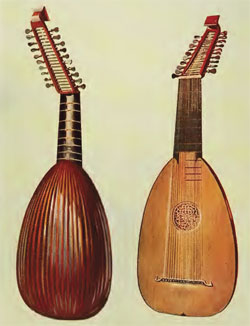Renaissance Lute
The lute was the most fashionable Renaissance instrument, truly characteristic for the period. Most musicians became proficient in playing it, while all kind of compositions were arranged to take advantage of the concerted effects of the lute.
It can be said that the lute decisively contributed to the development of a taste for true instrumental composition. Lute distinguishing features are the large pear-shaped or oval body, flat in front and vaulted behind , and the head or peg-box. The body was strengthened within by a sound post under the bridge and by one or more longitudinal sound bars.
The belly was pierced by up to three sound holes. They were carefully shaped and located. The lower ends of the strings were fastened to the bridge, usually placed obliquely and to one side. The neck varied in width and length, with a fretted fingerboard, and a head, either flat, curved or bent sharply back, in some cases almost at a right angle to the neck and finger-board.

Renaissance Lute
The head contained the tuning-pegs; usually about 12-13 strings of gut or wire, of which the uppermost or chanterelle was single. The others were tuned in pairs, the lower pairs being sometimes carried off at the side of the fingerboard and used without stopping. Because the sixteenth century instruments usually had six pairs of strings, or five pairs and a single string, six lines were used in the tablature for the lute music. The tone of the lute, produced by playing with the finger tips, was incisive and slightly nasal.
To facilitate the tuning and arrangement of the strings an additional peg-box was added at the top of the neck. This variation of the lute was called the archlute, and was used chiefly in orchestral performances. In its largest form of over six feet high it was called the chitarrone, which had an enormous neck, giving additional sonority to the deep bass strings or diapasons. The theorbo was a smaller tenor lute employed as an accompaniment to the voice.
A portrait of Lady Mary Sidney shows her with such an instrument, which she is supporting by her right hand, the lower end resting on the floor.
This type of lute construction led to great variations in size, from the little chiterna, with 4 strings, up to the big models with a double or extended neck and head and 20-24 strings.
As the weak bass of the harpsichord was not sufficient, the theorbo and chitarrone were invented in order to provide the thorough bass, intended to accompany the Florentine Recitativo.
In Renaissance France, a variety of lute called mandore was very popular, and was also used, beside the larger model, in Scotland. It was played with the fingers as well as with a plectrum. The actual pitch and number of strings varied with the size of the instrument, which was usually about twenty inches long. When comparing the two instruments, the lute had a deeper and fuller body than the mandore. In France the lute was much appreciated, the resonance created by its shape being considered better than that of the viol.
A small Renaissance instrument designed to be carried under the cloak, the pandurina, survived in the form of the mandoline, were the gut strings are replaced by those of wire, and the instrument is played with a plectrum.
On a general note, the lute, violin and guitar were played more in towns than in the countryside. The ladies preferred a keyboard instrument, the virginal, while the men favored the lute.
The name of Elizabeth I is traditionally attached to a fine instrument known as Queen Elizabeth's Lute. However, due to its technical characteristics, this beautiful instrument can be rather considered a guitar.
It is a wire strung instrument, so it belongs to the variety of guitar known as cither. The bridge is not set obliquely, so it resembles more a pandore or penorcon. It had, as this name indicates, ten strings, which were of wire, to be tuned in five pairs of unisons, and played with a plectrum.
The lute underwent numerous modifications, with diapasons or extra bass strings added. However, it was finally surpassed in popularity by the more useful, although less beautifully toned spinet. Probably a reason was the fact that with the spinet, music could be performed with two hands and obtain effects which even a very skilled lute player could not rival.
Among other stringed instruments including the harp, gittern, citole, psaltery, and various types of viol, the lute was used for accompanying the voice.
Some modern instruments like the guitar and the mandolin are actually variants of the lute, with the latter closely resembling it in shape.